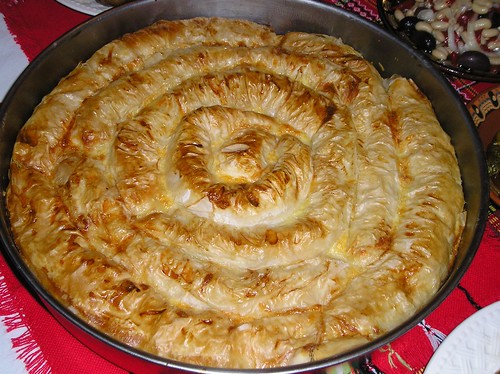Murals, frescos, and icon art have been an important medium
throughout the centuries, especially during the Middle Ages which saw a large
push towards the visual arts. And no doubt there was some outside influence
from the Romans and Greeks. Many art
schools started popping up, especially in the old capital of Tarnovo which
became a center for the arts. While it was similar to other schools of art, it
actually was unique in other ways, especially when it came to realism and
individualism. Many artists around this
time focused their skills on mural painting in churches. The Bulgarian National
Revival of the 18th and 19th centuries brought another
surge in promoting the arts, and as they gained their independence, they also
expanded their repertoire to include other European art movements.
One famous artist is Christo, who studied art at Sofia’s
Academy of Fine Arts before travelling around and eventually losing his
citizenship. His wife Jean-Claude (who was born in Morocco) did large works of
environmental art. Some of the famous ones are the Pont-Neuf Bridge in Paris,
The Gates in New York City’s Central Park, the 24-mile “Running Fence” in
California, and the wrapping of the Reichstag in Berlin.
 |
| The Gates -- looks like giant hurdles with curtains. |
The artist known as Pascin studied art in Paris (and
especially the art circles in and around Montparnasse) and was best known for
his influences in the Modernist movement. He created a lot of watercolor and
sketches, many of which he sold to newspapers and magazines. He had long
battled depression and alcoholism which had turned fatal with his suicide in
1930 at the age of 45. He divided his
estate equally between his wife and his mistress. I’m sure that left a few
people in awkward situations.
One of the most prolific painters from Bulgaria is Vladimir
Dimitrov. Later in life, he simply
became known as Maystora, or the Master.
He utilized many post-Impressionistic styles (as well as others) and
tended to use bright colors in his work as well. He was quite eccentric: he chose to live in
poverty, never wore new clothes or shaved, and ate a vegetarian diet. Some called him a saint, even while he was
still alive. Maystora Peak, part of the
South Shetland Islands (Antarctica) is named after him.
Bulgarian literature in general is any literature written in
the Bulgarian language, and is one of the oldest forms of literature of the
Slavic peoples. Of course, being the inventor of the Cyrillic alphabet sort of
puts Bulgarian literature in its place at the top of the class of Slavic literature,
and it led to the formation and expansion of literary schools, namely the
Preslav, Ohliv Literary School, and the Tarnovo Literary School. Medieval
literature is mostly centered around religious texts, treatises, hymns,
letters, and historical documents.
During the Bulgarian National Revival, as with the other
areas of the arts, literature also surged. One of the most important voices to
come out of this movement is Hristo Botev, notable poet and revolutionary.
Others include Lyuben Karavelov and Georgi Sava Rakovski (whose Gorski Patnik is considered one of
Bulgaria’s first literary poems).
Ivan Vazov is considered the “father of new Bulgarian
literature” in the years after the country gained liberation from the Ottomans.
He’s most famous for his book called Under
the Yoke which has been translated into over 30 languages.
Modern Bulgarian literature generally starts right around
the time of their independence, or the beginning of the 20th
century. It started to include and become influenced by other European
philosophies, but maybe only in parts. Symbolist poetry became a very common
catalyst for expressing political and social ideologies. Peyo Yavorov, Hristo
Smirnenski, and Dimcho Debelyanov were three such poets who developed and made
names for themselves as well as many others. The focal point of this movement
is like offering an alternate plane for the bleak realities around them. It’s
often full of emotions, yet intellectual with many historical and literary
references. It tends to be descriptive, refined, and introspective.
The communist years after WWII certain had its effects on
Bulgarian literature. Certain books were not able to be published and others
were required to be changed. However, as communism began to fade from this area
as a form of control, literature was allowed to grow and expand into many of
the popular genres of the 20th century found in Western and European
literature: surrealism, expressionism, existentialism, postmodernism, crime
fiction, science fiction, and structuralism.
Elias Canetti, mostly writing in German, became the first Bulgarian to
win the Nobel Prize for Literature in 1981.
 |
| Elias Canetti |
Up next: Music and Dance












































